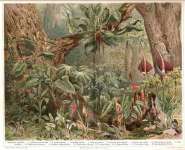This is strange. I typed in theMoBot Tropicos database the name "Philodendron cannifolium" and thename is accepted,
I googled for images and most ofthem show Ph. martianum or other popular species like Ph. sagittifoliumor Ph. hastatum.
To mix up more: I have and aldlithography which presents a species Philodendron cannaefolium (see theattachment), there's no such entry in Tropicos, but I found a pageshowing this "species" and it is not Ph. martianum, it resembles Ph.hastatum ("glaucophyllum"):
Another page says that Ph.cannaefolium is a synonym of Ph. martianum, but there are no photos:
And a forum page with photos of Ph.martianum and a long discussion after it
Have fun
Marek
-----Original Message -----
Sent:Friday, July 17, 2009 5:32 AM
Subject:Re: [Aroid-l] Does anyone know this Philodendron?
Correct Marek. The petioles which support eachblade of Philodendron martianum are spongy to the touch. They commonly possess a "C" shaped depression (sulcate orcanaliculate) down the adaxial (upper) surface and since the petiole'sare often swollen they likely store water or starches inside. Thereare also sharp ridges that define the edges of the canal.
The plant in your photos appear to be those of a juvenile specimen. The largest plant on my page is very large and is in the collection ofLeland Miyano in Hawaii. All the data on my page has also been checkedby aroid botanist Marcus Nadruz and others but I'm always anxious tohave any errors pointed out.
I've attached one of Leland's photos showing the size of the petiolesof his plant. I thought I had added this to the page but just found Ileft it off. I'll add it later tonight.
http://www.exoticrainforest.com/Philodendron%20martianum%20pc.html
Steve Lucas
www.ExoticRainforest.com
Marek Argent wrote: Hello,
I have photos of Philodendronmartianum and it has swollen petioles
Marek
-----Original Message -----
Sent:Thursday, July 16, 2009 5:26 AM
Subject:Re: [Aroid-l] Does anyone know this Philodendron?
I have several Philodendronmartianum which is often called Philodendron cannifolium and thecharacteristics are not a good match. I wrote a very detailed pagewhich is on the site about a year ago with both Brazilian botanistMarcus Nadruz' and Leland Miyano's help on how P. martianum cameto be called P. cannifolium. Interesting story but technicallythere is no such plant as Philodendron cannifolium. http://www.exoticrainforest.com/Philodendron%20martianum%20pc.html
I'm now checking out Pete's suggestions! Thanks for the input.
Steve
l
_______________________________________________
Aroid-L mailing list
Aroid-L@www.gizmoworks.com
http://www.gizmoworks.com/mailman/listinfo/aroid-l
Nie znaleziono wirusa w tej wiadomosci przychodzacej.
Sprawdzone przez AVG - www.avg.com
Wersja: 8.5.375 / Baza danych wirusów: 270.13.13/2237 - Data wydania:07/14/09 05:56:00

_______________________________________________Aroid-L mailing listAroid-L@www.gizmoworks.comhttp://www.gizmoworks.com/mailman/listinfo/aroid-l
--------------090608090402010301020807


